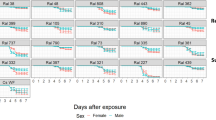Abstract
EXPERIMENTS have been conducted with isodrin and endrin labelled with carbon-14 in the terminal unchlorinated ring1 and with aldrin and dieldrin labelled in the chlorinated ring (from the Radiochemical Centre, Amersham). Adult insects used were of a susceptible strain (S) and dieldrin-resistant strains (R 1) and (R 2). R 1 arose from the S-strain by exposure of the larvæ to dieldrin and R 2 from R 1 by removal of the dieldrin pressure after 19 generations2.
This is a preview of subscription content, access via your institution
Access options
Subscribe to this journal
Receive 51 print issues and online access
$199.00 per year
only $3.90 per issue
Buy this article
- Purchase on Springer Link
- Instant access to full article PDF
Prices may be subject to local taxes which are calculated during checkout
Similar content being viewed by others
References
Brooks, G. T., J. Chem. Soc., 3693 (1958).
Winteringham, F. P. W., and Harrison, A., Nature, 184, 608 (1959).
Busvine, J. R., Nature, 174, 783 (1954).
Bellin, R. H., et al., U.S. Patent 2,768,181 (1956).
Perry, A. S., Mattson, A. M., and Buchner, A. J., J. Econ. Ent., 51, 346 (1958).
Lidov, R. E., U.S. Patent 2,635,979 (1953).
Author information
Authors and Affiliations
Rights and permissions
About this article
Cite this article
BROOKS, G. Mechanisms of Resistance of the Adult Housefly (Musca domestica) to ‘Cyclodiene’ Insecticides. Nature 186, 96–98 (1960). https://doi.org/10.1038/186096a0
Issue Date:
DOI: https://doi.org/10.1038/186096a0
This article is cited by
-
Body size variability of Varroa destructor and its role in acaricide tolerance
Parasitology Research (2012)
-
Aldrin and dieldrin uptake in insecticide-resistant and susceptible mosquitofish (Gambusia affinis)
Bulletin of Environmental Contamination and Toxicology (1975)
-
Epoxidation of Aldrin to Dieldrin by Lobsters
Bulletin of Environmental Contamination and Toxicology (1974)
-
�ber den Metabolismus von Endrin, Heptachlor und Telodrin
Qualitas Plantarum et Materiae Vegetabiles (1968)
-
Insecticide absorbed by the Central Nervous System of Susceptible and Resistant Cockroaches exposed to Dieldrin
Nature (1963)
Comments
By submitting a comment you agree to abide by our Terms and Community Guidelines. If you find something abusive or that does not comply with our terms or guidelines please flag it as inappropriate.



